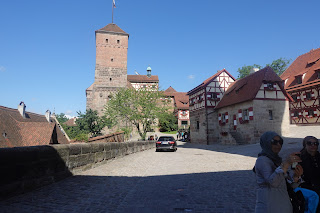Nuremberg and summit level of the Main Danube canal
Looking into the moat of the castle at Nuremberg.The bridge over the moat.
Some of the fortifications overlooking access to the castle.
Access is through a tunnel and around defences overlooking the approach through this gate.
A view from one of the battlements on the way up to the top of the castle.
Another view of the houses with their steep roofs where there was plenty of storage space.
One of the towers overlooking the approach to the main castle.
Another approach to the castle up a steep slope from the town below.
The final gate into the castle but it wasn't open to visitors.
The entry gate through the alternative access to the castle from the town.
A view of the castle views.
The oldest surviving house in the city. Note the traditional hole in the roof at the top of the gable, traditionally used to allow smoke out from the fire in the main room.
A beautiful building just below the castle.
Part of the inner walkway along the top of the walls, plus the house of the famous painter Albright Durer.
A detail on a building of St George.
A view of a street with several wooden balconies, frowned upon by Lutherans but if a Catholic moved out, they would take the balcony wth them.
A stone balcony, clearly not easily moveable but showed that they were there to stay.
The town hall entrance.
The iconic gold encrusted fountain in the market square of Nuremberg.
The main, western entrance to the cathedral.A beautifully restored old building.
A former municipal building, now an old folks home straddling the river.
And then we left Nuremberg and were soon entering one of the 25 metres deep locks on the canal.
The ships ropes weren't long enough to reach the top and crew wouldn't be able to throw a line that high...so the engineers used floating bollards to secure the ship. The bollards held the ship secure but would also rise as the water level rose.
Water is conserved by the use of side basins which store some of the water as the locks are used.
The top lock gate sinks into a a recess, seen here where the lock is full and the gate is about to be opened...
...the gates are descending...
...and the hand rails finally descend beneath the water and once the top of the rails are below two metres. the draught of out ship. we can exit the lock.We were finally traversing the summit level of the canal, celebrated by an art installation.
A wall but poignant as the year before the canal opened was the falling of the Berlin Wall.
Our first down lock with a boat coming out of it. Our turn to enter the first down lock on my journey.
The full lock.
The lock gate in front of us.
The lower lock gate opens...






































No comments:
Post a Comment